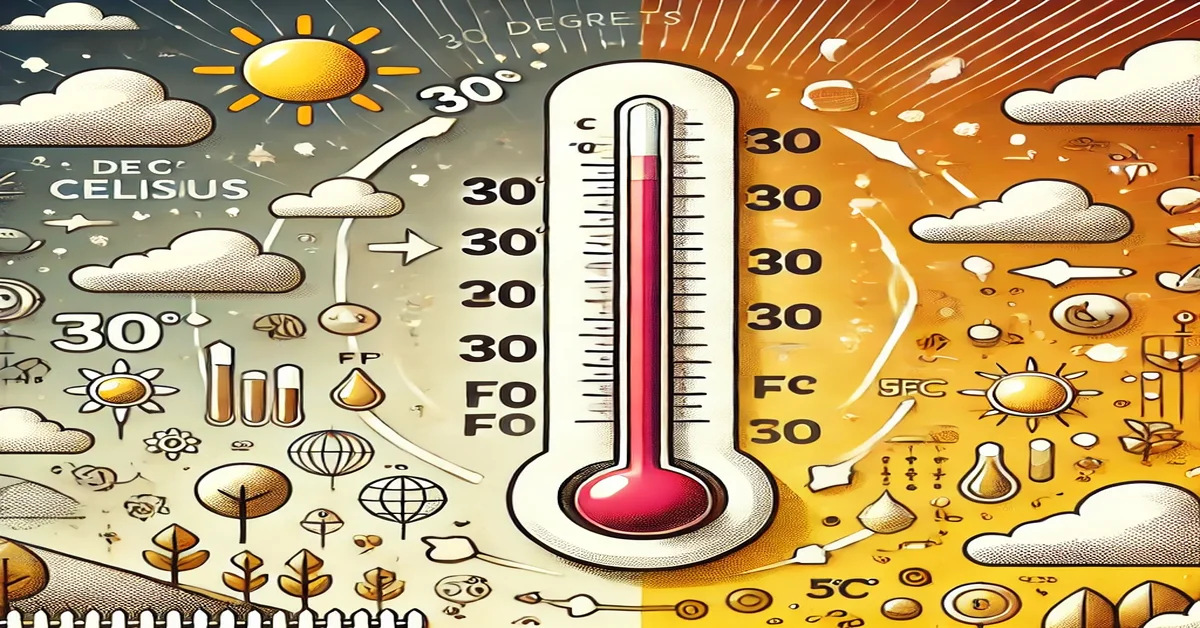Temperature is a fundamental aspect of our daily lives, influencing everything from the weather we experience to how we dress. But have you ever found yourself puzzled while trying to convert 30 degrees C to F? If you’re looking at 30 degrees Celsius and wondering what that means in Fahrenheit, you’re not alone. Understanding temperature conversion can seem daunting at first, but it doesn’t have to be.
In this post, we’ll break down the basics of converting temperatures between these two scales. We’ll specifically focus on turning 30 degrees C to F counterpart. Whether you’re traveling abroad or simply curious about temperature readings around you, mastering this conversion will enhance your knowledge and confidence in discussing weather conditions worldwide. So let’s dive in and unravel the mystery behind 30 degrees C to F!
Celsius to Fahrenheit Conversion Basics
Understanding temperature conversion is essential for many daily activities. Whether you’re traveling, cooking, or simply curious about weather reports, knowing how to convert Celsius to Fahrenheit can make a big difference.
The formula for converting Celsius (C) to Fahrenheit (F) is straightforward: F = (C × 9/5) + 32. This equation allows you to take any temperature in degrees Celsius and find its equivalent in degrees Fahrenheit.
For example, if you want to convert 30 degrees C to F, you would multiply by nine-fifths and then add thirty-two. This method provides an accurate result that can be easily replicated with other temperatures as well.
Beyond just the formula, it’s helpful to remember certain key reference points. Freezing point of water is at 0°C or 32°F while boiling point sits at 100°C or 212°F. Familiarizing yourself with these benchmarks makes conversions more intuitive and practical for everyday use.
How to Convert 30 Degrees Celsius to Fahrenheit
To convert 30 degrees C to F, you can use a simple formula. The equation is: F = (C × 9/5) + 32. This method allows for an accurate conversion between the two temperature scales.
Start by taking your Celsius value, which in this case is 30. Multiply it by 9/5 or 1.8. When you calculate that, you’ll get 54 degrees. Next, add 32 to this number to complete the conversion process.
So, adding those together gives you a total of 86 degrees Fahrenheit. Therefore, when someone mentions a warm day at 30 degrees C to F, they are effectively talking about it being around 86 degrees Fahrenheit.
This straightforward calculation makes it easy to understand how temperatures translate between these two systems and helps clarify weather reports from various parts of the world where different measurement standards are used.
Exploring the Conversion Process
To convert 30 degrees C to F, you can use a simple formula. The equation is F = (C × 9/5) + 32. This means you’ll multiply the Celsius temperature by nine-fifths and then add thirty-two.
Starting with our example, take 30 degrees Celsius. Multiply it by nine-fifths—this gives you 54. Next, add thirty-two to that result. So, when you calculate it out: 54 + 32 equals 86 degrees Fahrenheit.
Understanding this process helps clarify how temperatures are measured in different systems. Each scale has its unique reference points which affect daily life significantly—from weather forecasts to cooking instructions.
It’s also helpful to remember a few key benchmarks: freezing point of water is at both scales (0°C and 32°F), and body temperature averages around 37°C or roughly 98.6°F in Fahrenheit terms. Familiarity with these conversions makes everyday tasks easier and enhances your understanding of global climates.
Commonly Asked Questions about 30 Degrees C to F
Many people wonder about the relationship between Celsius and Fahrenheit. One common question is why these two systems are used globally. The Celsius scale is widely adopted in most countries for everyday temperature measurements, while Fahrenheit remains popular primarily in the United States.
Another frequently asked question concerns the exact conversion formula. To convert 30 degrees C to F, you multiply by 9/5 and then add 32. This simple calculation yields a result of 86 degrees Fahrenheit, providing an easy reference point.
Some might ask how significant this temperature feels in real life. At 30 degrees Celsius, conditions typically feel warm to hot for most individuals, making it ideal for outdoor activities or beach days.
People often inquire whether other temperatures can be converted similarly. Absolutely! You can use the same formula for any degree measurement from one system to another; just remember that each conversion will yield different experiences based on local climate and personal comfort levels.
Additional Resources and Related Content
For those looking to deepen their understanding of temperature conversions, plenty of resources are available. Websites such as Weather.com provide live updates on temperatures in various units, making it easy to see real-time conversions.
You can also find conversion calculators online that simplify the process for any temperature value. These calculators often allow you to input Celsius and instantly receive the equivalent Fahrenheit reading—perfect for quick checks.
Books on meteorology and physics often discuss temperature scales in detail, offering insights into why these systems exist and how they are used worldwide. For further learning, consider exploring educational platforms like Khan Academy or Coursera, which offer courses covering basic principles of science and mathematics including unit conversion topics.
Forums such as Reddit have communities dedicated to science where members share tips about practical applications related to temperature measurement. There’s a wealth of knowledge out there waiting for you; dive in!









